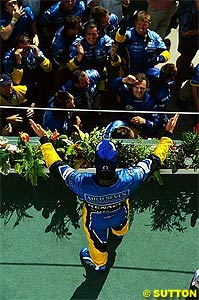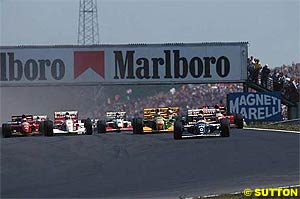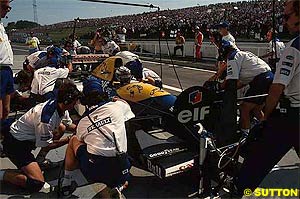
Atlas F1 Magazine Writer
Which driver has the best winning record after long in-season breaks? What has been the longest break during a Formula One season? What other records can Michael Schumacher clinch this weekend? Atlas F1's Marcel Schot brings the statistics and anecdotes ahead of the Hungarian Grand Prix
In more recent times the biggest gap was two months and 18 days between the 1990 Brazilian and San Marino Grands Prix. Originally this would have been a week shorter and with a non-championship race at Donington in-between on Easter Sunday. However, the race at Donington was cancelled due to a lack of interest and the San Marino Grand Prix had to be pushed forward a week.
With Hungary traditionally one of the warmer races of the season, it's a good time to look at the reliability of the teams. While McLaren clearly suffer from the complete lack of reliability at the start of the season, the Woking based team match Ferrari and Williams as the only teams to have completed every lap in the past three races.
While McLaren is overall worse than their budget would suggest, Sauber are performing well above their financial situation. This, no doubt, is helped by the abundance of Ferrari technology aboard the C23. The only laps Ferrari lost were when Schumacher collided with Juan Pablo Montoya in Monaco. This leaves Rubens Barrichello as the only driver to complete every lap this season.
While the main focus at the moment is on all the bickering about Jenson Button, Michael Schumacher can write history in several ways this weekend. The German currently ties his personal records of most wins in a season (11), most consecutive victories (6) and consecutive races led (12). While only the first is an actual record, the others show that the six time World Champion is very much at the height of his power and ever hungry for more.
This Week in History
On 15 August 1993 Damon Hill scored his first victory. The Briton had been promoted from Brabham driver and Williams test driver to the full time number two driver when Nigel Mansell opted to move to America rather than defend his title with Alain Prost as his teammate. While the Williams was as dominant as it had been in 1992, Hill had constantly been in the shadow of his much more experienced teammate. On the occasions that Prost hadn't won, it was Ayrton Senna in the McLaren-Ford who had taken the honours, leaving Hill rather frustrated without wins in a very strong car.
The next day Damon Hill made a giant leap forward in time, but was still two tenths short of his teammate, making it a Williams front row, followed by Schumacher, Senna, Patrese and Ferrari driver Gerhard Berger.
During the warm-up on Sunday morning, problems with the clutch became apparent for Alain Prost. Until race time the team were frantically working to resolve the problem, but as the drivers started the warm-up lap before the race, Prost stalled and was forced to start from the back of the grid. Of course, this left Hill alone on the front row as the race got underway and the Briton immediately made the best of it. The number 0 driver - number 1 was unavailable as the rules stated that this was the number to be carried by the World Champion, who in this case wasn't taking part in the championship - opened a gap of 1.7 seconds to Ayrton Senna in the first lap around the very hot Hungaroring circuit. Behind Senna, Michael Schumacher spun during the opening lap, but quickly regained himself and closed in behind Berger and Patrese.
In the first phase of the race Hill took full profit of the power of his car and only Senna was able to push hard enough to stay even remotely close. However, after ten laps the Brazilian was 9.4 seconds behind. Gerhard Berger in the Ferrari was clearly holding up the rest of the pack behind Senna. The gap between the Austrian and the McLaren in front of him had increased to 15 seconds, while no less than four cars were less than two seconds behind him. In the mean time Alain Prost had fought his way up to 13th place.
A lap later, Senna's engine started to act up and the Brazilian started losing more and more ground to Hill until he was forced to retire in lap 18. This left Hill with a massive lead of over 40 seconds. Berger was still leading the following group, with Schumacher and Patrese right on his tail. The surprising number five was Alain Prost, who was driving a fantastic race around the tight and twisty circuit. The Frenchman was just two seconds behind the man in front of him. At this time the first round of pitstops was starting and that's where Prost's march up the field ended. While pitting it was discovered that the mounting of his rearing was about to break, resulting in a nine-minute pitstop.
Between stops only Patrese was able to match Hill's pace and thus the Williams driver entered the pits for a second time with a 52-second lead and only two other cars on the same lap. For the remainder of the race Hill was strictly concentrating on getting the car home. He did so very well, eventually finishing the race 72 seconds ahead of Patrese, with Berger taking the final podium position.
After a three-week break the drivers can finally get in action again. While most of them will have enjoyed a vacation, they will no doubt be eager to climb into their tight working areas once again. After last year's summer break it was Fernando Alonso who returned as the best, breaking a series of four wins for Ferrari after extended leaves. Since then, both races with a break of longer than two weeks - the 2003 Italian Grand Prix and the 2004 San Marino Grand Prix - have been won by Michael Schumacher. With the exception of his first year at Ferrari, the German has returned very strong after longer breaks. In the last ten years he won eight of the 19 races that took place more than two weeks after the previous one. Both Damon Hill and Mika Hakkinen won three, Jacques Villeneuve two and Fernando Alonso, Rubens Barrichello and Eddie Irvine one each.
 The biggest gap between two races within a season was no less than four months and 28 days. This was the case when it was decided to hold the 1965 South African Grand Prix on 1 January as round one of the championship, followed by the Monaco Grand Prix in a more traditional time slot of 30 May. However, it wasn't uncommon in the 1950s and 1960s to hold first rounds in January or last rounds in December. The longest gap between races that didn't involve the first or last race of a season was in 1974. The first two rounds of the season in Argentina and Brazil were held two weeks apart in January, after which the teams had to endure a break of three months and two days until the South African Grand Prix at the end of March.
The biggest gap between two races within a season was no less than four months and 28 days. This was the case when it was decided to hold the 1965 South African Grand Prix on 1 January as round one of the championship, followed by the Monaco Grand Prix in a more traditional time slot of 30 May. However, it wasn't uncommon in the 1950s and 1960s to hold first rounds in January or last rounds in December. The longest gap between races that didn't involve the first or last race of a season was in 1974. The first two rounds of the season in Argentina and Brazil were held two weeks apart in January, after which the teams had to endure a break of three months and two days until the South African Grand Prix at the end of March.
Ferrari 1518 97.9%
Sauber 1358 87.6%
Williams 1350 87.1%
Renault 1331 85.9%
BAR 1326 85.5%
Toyota 1277 82.4%
Jordan 1164 75.1%
Jaguar 1157 74.6%
McLaren 1155 74.5%
Minardi 1056 68.1%
 Friday qualifying at the Hungaroring continued in the same vein as the rest of the season. Alain Prost completely dominated and set a time over half a second quicker than number two Michael Schumacher, who stayed narrowly ahead of Damon Hill. Behind the two Williams and Benetton the gap was huge. Fourth-placed Riccardo Patrese, in the second Benetton, was no less than 2.2 seconds behind Prost, with Ayrton Senna in the first McLaren fifth another half a second back. The surprising number six was Pierluigi Martini in the Minardi, who was almost a full second behind Senna and a massive 3.6 behind Prost.
Friday qualifying at the Hungaroring continued in the same vein as the rest of the season. Alain Prost completely dominated and set a time over half a second quicker than number two Michael Schumacher, who stayed narrowly ahead of Damon Hill. Behind the two Williams and Benetton the gap was huge. Fourth-placed Riccardo Patrese, in the second Benetton, was no less than 2.2 seconds behind Prost, with Ayrton Senna in the first McLaren fifth another half a second back. The surprising number six was Pierluigi Martini in the Minardi, who was almost a full second behind Senna and a massive 3.6 behind Prost.
 When Hill stopped after 24 laps, he returned with a 24-second lead over Schumacher and barring incidents the race was already in the bag. Behind the Briton everybody seemed to try and make things as comfortable as possible for the leader. Jean Alesi tangled with Christian Fittipaldi and both drivers retired, while the drivers closest to Hill hadn't stopped yet. Shortly after Schumacher's stop on lap 25, the German's engine gave way, so when Patrese finally pitted another three laps later, the Italian was able to keep second place, albeit 53 seconds behind Hill.
When Hill stopped after 24 laps, he returned with a 24-second lead over Schumacher and barring incidents the race was already in the bag. Behind the Briton everybody seemed to try and make things as comfortable as possible for the leader. Jean Alesi tangled with Christian Fittipaldi and both drivers retired, while the drivers closest to Hill hadn't stopped yet. Shortly after Schumacher's stop on lap 25, the German's engine gave way, so when Patrese finally pitted another three laps later, the Italian was able to keep second place, albeit 53 seconds behind Hill.
|
Contact the Author Contact the Editor |
Please Contact Us for permission to republish this or any other material from Atlas F1.
|
Volume 10, Issue 32
Articles
The Piranhas Bite Again
Technical Analysis: The FIA Proposals
Man in the Middle
Every Other Sunday
2004 Hungarian GP Preview
2004 Hungarian GP Preview
Hungarian GP Facts & Stats
Columns
The F1 Trivia Quiz
Rear View Mirror
Bookworm Critique
On the Road
Elsewhere in Racing
The Weekly Grapevine
> Homepage |